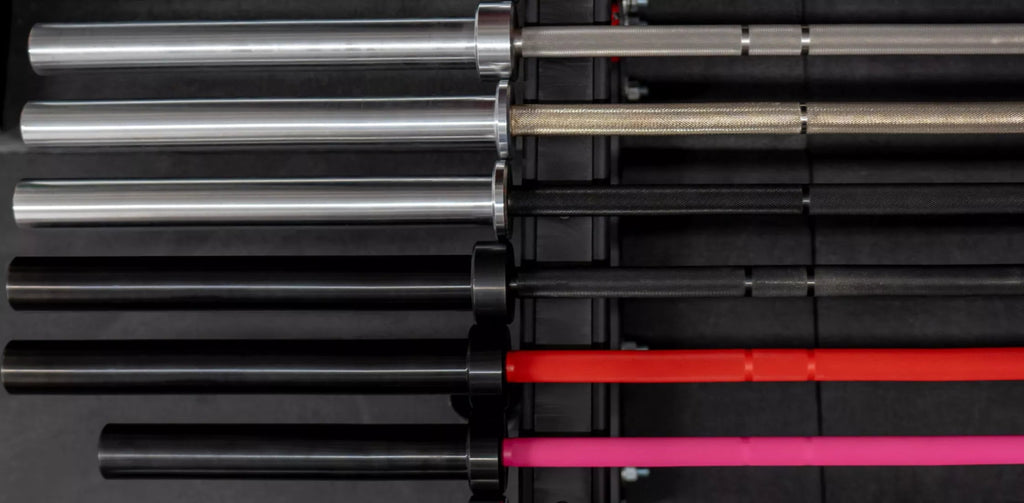How Long is a Barbell?

One question you should ask yourself is about how long a barbell truly is. Why does it matter? The length of a barbell can have a big impact on the way it is used. Some barbells are shorter and rigid while others are longer and provide more whip. Regardless, the length of a barbell can change the form you execute and if it makes sense for the needs within training.
So how long is a barbell? A typical barbell used in strength training is about 86 inches long. Not all barbells are built the same, though. Some barbells are built shorter, longer, or right around 86 inches. The length of the barbell has a huge impact on the performance of the bar, whether it’s used for traditional strength movements, Olympic movements, and more.
In this article, we will discuss more dimensions of a barbell besides length. We will talk about the purpose of a barbell, different types of barbells, their dimensions, and some alternatives to the barbell. One thing is for sure, though. The use of a barbell within any program should be a priority. The barbell provides many benefits to your strength, and without it, you could be limiting yourself and how much you can grow in your strength.
Let’s get right to it!
What is a Barbell
A barbell is a fundamental piece of gym equipment designed as a form of resistance for strength training and weightlifting exercises. The barbell is a long metal bar with evenly spaced weights attached at each end of it. A barbell includes loadable sleeves, rotating collars, a lifting shaft, knurling on parts of that lifting shaft, and either bare steel, stainless steel, or a special coating for cosmetics and or grip strength.
Barbells are versatile tools that play a crucial role in strength-building routines. They also play a key role in competition as well. They provide a platform for compound exercises such as squats, deadlifts, bench presses, and overhead presses, engaging multiple muscle groups simultaneously. A barbell can overload your strength much more than any other form of resistance. This has to do with how the barbell is designed, and how you can lift heavier weights due to how resistance is displaced and the different techniques you can apply with a barbell.
Barbells can also play a role in other types of programming, whether you want to get bigger, stronger, or faster. However, their main purpose is to provide a stimulus for challenging your muscular fitness.
Different Types of Barbells
Below, we will discuss the different types of barbells that are similar to a traditional straight barbell. There are standard barbells in the market we could discuss. However, those types of barbells are inconsistent with their dimensions, and they are not ideal for those who want to increase their strength and performance.
- Olympic Barbell
- Power Bar
- Deadlift Bar
- Squat Bar
- Axel Bar
- Speciality Bars
Olympic Barbell:
Length: 86 inches
Diameter: 28-29mm
Loadable Sleeve: 16 inches
An Olympic barbell is a standardized weightlifting bar used for Olympic movements such as the clean and snatch. It weighs 20 kilograms (44 pounds) for men and 15 kilograms (33 pounds) for women. Olympic barbells have a 28mm or 29mm shaft diameter and rotating sleeves to accommodate for dynamic movements like the clean and snatch.
Power Bar:
Length: 86 inches
Diameter: 28-30mm
Loadable Sleeve: 16 inches
A power bar, also known as a powerlifting bar, is designed for powerlifting exercises such as the squat, bench press, and deadlift. It is stiffer and more rigid than Olympic bars, with a thicker shaft diameter between 28-30mm. This level of strength is to help improve performance with lifting heavier loads. It has a more aggressive knurling for better grip to support these loads.
Deadlift Bar:
Length: 90-92 inches
Diameter: 27mm
Loadable Sleeve: 16-16.5 inches
A deadlift bar is specifically designed for the deadlift exercise. It is longer and thinner than standard or Olympic bars, allowing for more flex in the bar. The flex helps to reduce the range of motion and makes it easier to break the bar off the ground through the use of techniques such as the “slack pull”.
Squat Bar:
Length: 90-94 inches
Diameter:30-32mm
Loadable Sleeve: 16-16.5 inches
A squat bar is just like the power bar. The differences are with the length of the bar and the toughness of the bar. Since the barbell squat is historically a stronger movement, the bar needs to be tough and rigid in order to squat with ease. Squatting with a bar that has a ton of whip could cause the lifter to experience too much instability that could disrupt their strength.
Axel Bar:
Length: 80-86 inches
Diameter: 48-50mm
Loadable Sleeve: 15-16 inches
The axel bar is a thicker barbell with a larger diameter than other types of barbells. It is often used in strongman training and competitions. The increased diameter challenges grip strength and recruits different muscles during exercises. Axel bars may not have the same rotating sleeves as other bars which makes it very challenging to use.
Specialty Bar:
In addition to the variations of a barbell above, there are specialty barbells that lifters use to elicit a specific stimulus in training. These specialty bars below have odd dimensions compared to a traditional type of barbell. I will not break down the dimensions of each speciality bar below but will acknowledge them as a tool used in fitness to help improve strength and performance.
- Trap Bar
- Safety Squat Bar
- Cambered Bar
- Swiss Bar
- Yukon, Buffalo, and Duffalo Bar
Benefits of a Barbell
Three big benefits to using a barbell in training are:
- Versatility
- Overloading strength
- Challenging stability and core strength
Versatility:
A top benefit of using a barbell in strength training is its level of versatility. The length of the barbell allows for a wide range of exercises targeting various muscle groups. Whether its compound movements like squats, deadlifts, and bench presses or isolation exercises such as bicep curls or skull crushers, the barbell serves as a versatile tool that accommodates different workout routines. If you’re looking to build a successful workout, having some type of barbell is a must.
Overloading Strength:
Using a barbell allows someone to lift more weight than they could using other forms of resistance. Through the principles of biomechanics, it’s much easier to perform overloading movements using a barbell due to its design and structure. The idea is that the more you can lift, the more you can challenge your anatomy. This is a huge benefit to using a barbell in training. The ability to easily add or remove weights from the bar allows individuals to incrementally increase resistance as their strength improves. This adaptability ensures that muscles are continuously challenged, promoting consistent growth and development over time.
Challenging Stability and Core Strength:
Barbell exercises require a significant degree of stability and core engagement, contributing to improved overall athleticism and functional strength. Unlike certain gym machines that provide stabilization, barbell exercises demand coordination and balance through the design and length of the barbell. This engagement of stabilizing muscles not only enhances the effectiveness of the primary muscle groups, but helps to build a more functional and balanced physique. The need for core stability during exercises like squats and deadlifts with a barbell translates into improved core strength as well.
Alternatives to a Barbell
Other alternatives to a barbell to challenge your muscular strength are:
- Dumbbells
- Kettlebells
- Resistance Bands
- Medicine Balls
Dumbbells:
Dumbbells are handheld weights that offer a wide range of motion and allow for unilateral exercise, promoting balance and coordination amongst the body, muscles and joints. Dumbbells are suitable for both isolation and compound movements, providing flexibility in designing workouts. They are particularly advantageous for individuals with joint pain and need exercise variations to meet their needs.
Kettlebells:
Kettlebells are weights with a unique design featuring a handle, allowing for dynamic and swinging movements. Kettlebell exercises often involve both strength and cardiovascular components, making them an excellent choice for functional fitness. The design of the kettlebell provides a weight distribution that challenges stability, coordination and athleticism. Kettlebells are popular for exercises like swings, snatches, and more.
Resistance Bands:
Resistance bands are elastic bands of varying intensities, providing a different form of resistance compared to traditional weights. They are lightweight, portable, and ideal for home workouts or on-the-go training. Resistance bands are versatile, allowing for both upper and lower body exercises. They are particularly beneficial for individuals focusing on rehabilitation, as they provide a controlled and gradual increase in resistance, minimizing the risk of injury.
Medicine Balls:
Medicine balls are weighted balls available in various sizes and weights. They are versatile tools for explosive and dynamic movements, such as slams, throws, and twists. Medicine ball exercises engage multiple muscle groups and enhance coordination and power. They are often used for functional training and are suitable for individuals looking to incorporate a mix of strength and cardio into their workouts.
Conclusion
The length of a barbell has a great impression on your performance in the weight room. Typically, a barbell measures to be around 86 inches in length. However, there are other variations of the traditional straight barbell that could cause the barbell to be longer than 86 inches. This has to do with altering the functionality of the bar to cater to the movement.
Barbells are a versatile tool that play a big role in building strength. In this article, we discussed all types of barbells related to the traditional straight barbell. The barbell is a superior form of resistance as it can overload your strength much more than any other form of resistance. The reason you can overload your strength, though, also has to do with the length of the barbell.
As you can tell, the length of a barbell is a huge indicator of performance. Make sure that depending on your goals and programmed movements, you use the right bar that will meet your needs for performance.


